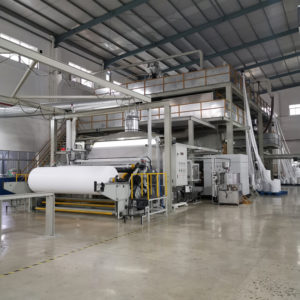A PP (polypropylene) Spunmelt Machine, also known as a nonwoven fabric production machine, is used to manufacture nonwoven fabrics, including those used in various applications such as diapers, hygiene products, medical products, and more. Waste management and recycling in the context of a PP Spunmelt Machine involve handling the waste generated during the production process and the potential recycling of materials.
Waste Management: Waste generated during the production process of PP Spunmelt fabrics can include trimmings, offcuts, rejected products, and scraps. Proper waste management practices are essential to minimize the environmental impact and promote sustainability. The specific waste management practices can vary depending on the facility and local regulations, but some common approaches include:
Waste Segregation: Separating different types of waste materials, such as fabric scraps and packaging materials, for appropriate disposal or recycling.
Recycling and Reuse: Identifying opportunities to recycle or reuse waste materials within the production process or in other applications. For example, fabric scraps or offcuts may be processed and reintroduced into the production line, reducing waste generation.
Waste Disposal: Proper disposal methods for non-recyclable waste, adhering to local waste management regulations and practices. This may involve sending waste to appropriate treatment facilities, such as waste-to-energy plants or landfill disposal.
Recycling: Recycling efforts in the context of a PP Spunmelt Machine can focus on the recycling of post-consumer or post-industrial nonwoven fabrics made from polypropylene. Recycling processes for nonwoven fabrics can be complex due to the combination of different materials used, such as polymers, additives, and fibers. However, advancements in recycling technologies are being made to improve the recyclability of nonwoven materials.
Mechanical Recycling: Mechanical recycling involves processes such as shredding, grinding, and melting to break down the nonwoven fabrics into reusable polypropylene pellets or flakes. These recycled materials can then be used in the production of new nonwoven fabrics or other plastic products.
Chemical Recycling: Chemical recycling methods aim to break down the polypropylene into its basic components, such as monomers or other chemicals, which can be used as feedstock for the production of new polymers or other materials.
Research and Development: Ongoing research and development efforts are focused on improving recycling technologies, exploring new recycling methods, and finding innovative ways to enhance the recyclability of nonwoven fabrics.
It’s important to note that the specific waste management and recycling practices can vary among different manufacturers and facilities. PP Spunmelt Machine Compliance with local regulations, adherence to industry best practices, and continuous improvement initiatives play a critical role in minimizing waste and maximizing recycling opportunities in the PP Spunmelt production process.
How is the quality of the products produced by a PP Spunmelt Machine ensured?
The quality of products produced by a PP Spunmelt Machine is crucial for ensuring customer satisfaction, product performance, and compliance with industry standards. Manufacturers employ various measures to ensure product quality throughout the production process.
Here are some common practices used to ensure the quality of products produced by a PP Spunmelt Machine:
Raw Material Control: Quality control starts with the selection and control of raw materials. Manufacturers typically have strict specifications for the polypropylene (PP) resin and other additives used in the production process. Raw material testing is conducted to ensure that the materials meet the required standards and specifications.
Process Monitoring: Continuous monitoring of the production process is essential to identify and address any variations or deviations that could impact product quality. Process parameters such as temperature, pressure, line speed, and airflow are monitored and adjusted as necessary to maintain consistent product quality.
In-line Quality Checks: Automatic inspection systems are often integrated into the production line to conduct real-time quality checks. These systems can detect defects, such as holes, tears, or inconsistencies in the fabric, and trigger alarms or automated corrective actions to minimize the production of defective products.
Sampling and Testing: Regular sampling and testing of the produced nonwoven fabrics are performed to assess their physical properties, such as basis weight, tensile strength, elongation, and barrier properties. These tests help ensure that the fabrics meet the required specifications and performance standards.
Quality Assurance Personnel: Qualified quality assurance personnel are responsible for conducting inspections, audits, and quality control activities at various stages of the production process. They may perform visual inspections, dimensional checks, and other quality tests to verify the conformity of the products.
Standard Operating Procedures (SOPs): Well-defined SOPs are established for each step of the production process, including machine setup, start-up, operation, and maintenance. Following standardized procedures helps ensure consistency and reduces the likelihood of errors or variations that could impact product quality.
Quality Certifications and Standards: Manufacturers may seek certifications such as ISO 9001 (Quality Management Systems) or adhere to industry-specific standards to demonstrate their commitment to quality and compliance. These certifications and standards provide a framework for implementing quality management systems and continuous improvement practices.
Customer Feedback and Complaint Handling: Customer feedback and complaints are valuable sources of information for identifying potential quality issues. Manufacturers actively collect and analyze customer feedback, promptly address complaints, and take corrective actions to improve product quality and customer satisfaction.
By implementing these measures, manufacturers of PP Spunmelt products aim to ensure consistent product quality, meet customer requirements, and uphold industry standards. Continuous improvement initiatives and a strong quality management system are often integral to maintaining and enhancing the quality of products produced by a PP Spunmelt Machine.
